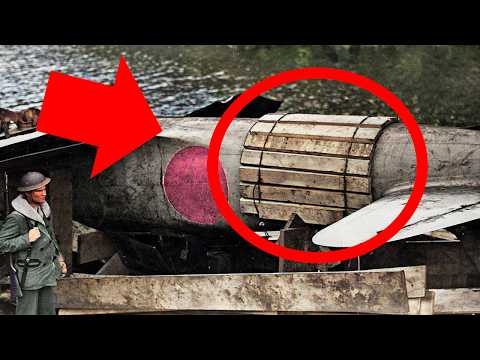The Most Important Airplane the US Ever Shot Down?

To many Americans, the phrase “made in Japan” was synonymous with low quality and rudimentary technology. But this perception changed after the surprise attack on Pearl Harbor, in which they were violently introduced to a groundbreaking piece of Japanese engineering: the formidable Mitsubishi A6M Zero. For the following months, the US military scrambled to keep up with the nimble fighter, and it quickly earned a mythical reputation. The warplane seemed to be everywhere in the Pacific, had an unprecedented range, and could easily outmaneuver anything the Allies threw at it.
More concerning was the fact that it was a seaborne aircraft designed to be launched by Japanese carriers. These ships were supposed to be inferior to land-based fighters due to their space restrictions; still, the Zero was outclassing every single land warplane. The US went to great lengths to capture one of these machines and learn how they were made and what made them so powerful. However, the Japanese were highly protective of their
technology, and they would crash their own aircraft before risking being captured. On July 12, 1942, the tide abruptly changed when a US Navy patrol crew landed on the island of Akutan following a strange series of events that led to an aircraft being flipped upside-down. Still, the plane was intact and immediately rushed to Naval Air Station in San Diego, California.
The secrets of the A6M Zero were about to be uncovered… Hard to Believe US intelligence had been informed of the existence of a new Japanese fighter back in the summer of 1940 as the Zero obliterated the ancient Chinese biplanes trying to defend their homeland. Specialists like Claire Lee Chennault cautioned the West about Japan’s incredible fighters describing their performance as: (QUOTE) “Like hawks in a chicken yard, they shot down the Chinese fighters before the defenders knew what hit them.” Nevertheless, the Americans paid little attention to what they thought were embellished Chinese reports and were confident that whatever the Japanese had concocted would be far inferior to their own technology. It wouldn’t be until the shocking attack on Pearl Harbor that they finally started to notice. As it turned out, Chinese reports had been correct; the Mitsubishi A6M Zero was a formidable machine, extremely fast and nimble, and with an incredible climb rate.
Early US encounters with the Zeros often resulted in tragedy, as the agile warplane easily outmaneuvered them in dogfights and shot them down into the sea. US pilots were also quite green compared to their Japanese counterparts, who had years of experience fighting against China, leaving them with an aggressive and experienced outlook in battle. The American fighters also found themselves at a significant disadvantage. Their P-40 Warhawks and F4F Wildcats were slightly faster than the Zero, but the US aircraft could not outmaneuver the Japanese warplanes and would often be shot down.
Moreover, even as British pilots were used to engaging German and Italian fighters, their European tactics fell short when they employed them against the agile Zeros and their virtuoso pilots. The Allies didn’t know it at the time, but Japan only had 521 active Zeros by then. Still, their range was so extensive that they could cover vast regions, giving the impression that they were everywhere.
Rumors and conspiracy theories soon began to spread, claiming that the Zero was actually a Western design. This myth persisted for several years and was even fueled by none other than Howard Hughes, who said in 1954: (QUOTE) “I should say in point of aircraft design and mechanical aptitude… nobody expected the Japanese to have an airplane that would be at all competitive [...] It was quite apparent to everyone that it had been copied from the Hughes [H-1] plane.” Changing Tactics During the early stages of the war, the Zeros achieved an incredible 12-to-1 air-to-air kill ratio against Allied aircraft. This figure surpassed even the Japanese pre-war estimates of a five-to-one kill ratio advantage.
Soon, the Allies were forced to avoid dogfights with the Japanese warplanes and instead used “Boom and zoom” tactics, diving into the Zeros from the clouds, shooting them, and then diving away. This tactic finally evened the odds against the Japanese powerhouse, as the light Zero was incapable of keeping up with British and American fighter planes during a dive. Nevertheless, the maneuver was not easy to implement on a wide scale; for one, the Allied pilots were trained to dogfight, and changing their now-instinctive behavior took time and additional training. Moreover, some American commanders considered the diving engagement cowardly and pressed their pilots to continue to dogfight, leading to severe losses.
Still, as impressive as the Zero’s performance was, its reign over the Pacific skies was not meant to last. The aircraft seemed almost perfect to the Allied strategists, but in reality, it had several significant flaws that could prove their end if discovered. Japan was hoping for a brutal but swift war, where they would force the US to sue for peace while continuing conquering Asia unopposed. But as the war dragged on, a complex race began;
the Americans needed to capture an intact Zero to learn its weaknesses, while the Japanese needed to protect their precious warplane and end the war as soon as possible. A Stranger On Niihau Island The Japanese pilots were instructed to crash or destroy their Zeros before risking the Allies capturing the technology, even at the expense of their own lives. During the attack on Pearl Harbor, the Zero piloted by Shigenori Nishikaichi was hit by a P-36 while on the operation’s second wave. Nishikaichi quickly realized the severity of
the situation, as his damaged Zero would not be able to make it back to the aircraft carrier. The pilot then rerouted for Niihau Island, the agreed location to land in case of an emergency. However, the Japanese intelligence assumed the small island was uninhabited, and they would soon find out that was far from the truth. As Nishikaichi performed a forced landing, he hit a metal fence and crashed, slamming his face against the instrument panel. Howard Kaleohano, a local resident,
found the unresponsive pilot and took his pistol and documents before he could wake up. The island dwellers had no idea about the attack on Pearl Harbor and Kaleohano took the pilot to his home, but when communications proved futile, he called for three Japanese-immigrant friends to translate. The pilot then informed them of everything that occurred in Pearl Harbor and the incoming war, but they didn’t tell Kaleohano and his wife. Things remained calm for a while, but the next day the island inhabitants learned of the Pearl Harbor attack on the radio, and all hell broke loose.
Chaos! As Kaleohano realized what was happening, he told Nishikaichi that he would keep his documents and turn them to the US authorities. Meanwhile, the islanders posted guards to keep a watch on the Zero pilot, but the Japanese immigrants did everything they could to help the pilot, even attempting to bribe Kaleohano so he would return the documents. These included the Pearl Harbor attack plans, Japanese transmission codes, and the pilot’s personal papers. Nishikaichi knew he could not let the Americans seize his documents or his plane under any circumstance. The Japanese nationals then helped him escape while playing music on a phonograph, took the guard’s weapon, and rushed to Kaleohano’s house to get the documents back. The Japanese fired on
Kaleohano on sight, but the Hawaiian managed to escape. At that moment, the whole village started to panic, with most residents running to the inner island’s caves for protection. After the encounter, the pilot and his Japanese allies tried to contact the Japanese military using the Zero’s radio. When they failed, they instantly set the warplane on fire to ensure the Americans never discovered its secrets.
They then went back to look for the documents and took another local married couple as hostages, threatening the husband to bring Kaleohano and the documents. As the man deceived the Japanese loyalists and returned to save his wife, a brutal fight ensued. The local husband was severely injured by gunfire, but his wife managed to take the Japanese pilot down, and the remaining enemy decided to take his own life.
The documents were then turned in to American authorities, but the plane had been destroyed, and its remains were of little use to the US military. Regardless, the brutal incident in Niihau Island led the Americans to believe every Japanese immigrant was a possible Japanese agent, and the incident would be used to justify the Japanese internment camps in the mainland USA. Capturing a Zero Days before the Battle of Midway, the Japanese launched a major offensive on the American base at Dutch Harbor in the Aleutians. Amid the daring Zero pilots deployed from Japanese aircraft carriers Ryujo and Junyo was Petty Officer Tadayoshi Koga, whose Zero fighter took a hit that severed the oil line, demanding an immediate forced landing. Desperate and in a state of shock, Koga spotted a large open field on the Island of Akutan, where he believed he could land safely. He then lowered his landing gear and prepared for an emergency touchdown, not realizing the grass was actually hiding a swamp.
As the Zero’s wheels struck the water, the uncontrollable aircraft flipped over on its back. The cockpit slammed against the water, and Koga could not free himself before the murky water overwhelmed him. Still, as the pilot went down, his Zero remained mostly intact. The following month, the crew of a Catalina from Patrol Squadron 41 spotted an overturned fighter while returning from a sortie and announced it. Then, on July 12, 1942, a US Navy Patrol crew landed near the crash site and examined the warplane; to their amazement, it was a Mitsubishi Zero in very decent conditions. The warplane was successfully salvaged and sent to Naval Air Station in San Diego, California, where it was quickly repaired to flying condition and painted in a US Navy color scheme. While there, the aircraft was methodically tested, its performance probed under various conditions, and it was taken apart to study it thoroughly.
Fortunately for the Americans, the examination revealed a series of serious flaws that would bring the Zero’s reign over the Pacific to an anticipated end. Inside the Machine Early tests revealed that the Zero was an engineering marvel. It also demonstrated that the design was unique to Japan and had not been acquired from any specific Western power.
The Americans quickly learned that the design prioritized range, agility, and maneuverability over everything else and began understanding the intricate details of Jiro Horikoshi’s incredible creation. Captain Eric Brown, the Chief Naval Test Pilot of the Royal Navy, would describe the overall opinion of the Allied high command when he said: (QUOTE) “I don’t think I have ever flown a fighter that could match the rate of turn of the Zero. The Zero had ruled the roost totally and was the finest fighter in the world until mid-1943.” The aircraft could reach speeds of up to 500 kilometers per hour and climb to altitudes of over 10,000 kilometers while carrying an impressive armament of two 7.7-millimeter machine guns and two 20-millimeter cannons. Moreover, the Zero had a previously unseen range for any fighter, being able to fly for over eight hours at cruising speed and for two hours at maximum speed.
To achieve these numbers, the Zero incorporated some of the world’s most advanced aeronautic advances. It had thin elliptical wings that minimized drag, its hull was assembled using groundbreaking Flush Riveting techniques, and Horikoshi had employed a state-of-the-art heat-treating procedure to allow for a complete metal structure. The inner metal skeleton that gave the warplane its shape was perforated with circular holes to make the aircraft lighter. The sheet metal that covered the structure was also extremely lightweight, with only 1.2 millimeters of thickness. Overall, the aircraft weighed up to 1,260 kilograms less than the American Wildcat.
The design philosophy employed by Jiro Horikoshi dictated that the ultimate fighter didn’t need armor plating and hefty protection as long as its speed and agility made it almost impossible to be hit. The aircraft was also specially designed to be seaborne, with a relatively short 9-meter wingspan that allowed it to be easily moved and stored onboard carriers, while its hollow inner structures enabled it to float. Jiro Horikoshi made significant sacrifices to keep his creation light and nimble, but these flaws were about to be exploited by the US forces. Shortcomings American pilots had noticed that despite the incredible challenge of actually hitting a Zero, once they struck, it would quickly burst into flames or explode. The engineers now knew why, as the Zero didn’t have any additional armor in the engine, fuel tank, or cockpit, and a single hit could destroy the aircraft. Additionally, the sheet metal covering the warplane was so ludicrously thin that even getting into the plane could puncture the hull and severely damage the aircraft’s structure.
To solve this, Horikoshi included button-activated emerging footholds and handles to help pilots get into the aircraft without damaging it. Moreover, the Americans discovered a significant flaw in the Zero’s performance; it was fast and agile, but couldn’t showcase both advantages simultaneously. As the Zero reached maximum speeds, the control surfaces that allowed it to turn became stiff and unresponsive, significantly diminishing its agility. In his quest to keep the Zero as light as possible, Horikoshi had relinquished adding hydraulics to the control surfaces, meaning that the faster the aircraft flew, the less responsive it became.
The engine also suffered from a float carburetor, severely impacting its otherwise remarkable Nakajima Sakae 1,130-horsepower engine. Like the Merlin engine used in British planes like the Spitfire and the Hurricane, the Zero engine’s float valve tended to open during zero-G maneuvers, flooding the engine and shutting down during operation. As the Allies took notice of the Zero’s sluggish performance and high speeds, its incredible fragility, and its inability to maintain stability during Zero-G maneuvers, they were ready to turn the tables on the apparently invincible Japanese fighter.
The Downfall The jaw-dropping performance of the Zero against Allied warplanes during the initial months of the war in the Pacific could not be sustained for long. One reason for its inevitable deposing was that the US simply had a much more capable wartime industry and much more extensive deposits of strategic resources that allowed it to quickly produce new and more powerful aircraft like the Grumman F6F Hellcat. Japan had little strategic resources and minimal manufacturing capabilities; thus, unlike Allied aircraft, they could not afford to polish the Zero’s flaws, such as the float carburetor and the rigid control surfaces. The light aircraft would have to continue fighting with its now-disclosed weaknesses.
Additionally, Japan’s shattered hope of a harsh but brief war had other disadvantages, as their methodical and exceptional pilot training program was designed to deliver only a hundred or so formidable pilots every several months. By the end of 1942, the nation was quickly running out of the highly experienced airmen that had shredded through the Allies in the initial months of the war. Additionally, American aviators were being trained to swiftly identify Zeros and employ a specific array of tactics. The pilots were to maintain high speeds at all moments to deny the Japanese aircraft its low-speed agility, and they were prohibited from engaging in dogfights, limiting themselves to swift diving hit-and-run attacks that forced the Japanese to keep up with the Allies’ speed instead of the other way around.
Knowing now how fragile and lightly armored the Zeros were, the Allied pilots were aware that one lucky hit was more than enough to take them out of the sky. Soon, Allied airmen would easily obliterate the Japanese Zeros in large numbers, and even the Wildcats were regularly shooting down A6Ms. A Grim Fate By early 1944, the Zero’s performance was so unexceptional and the Japanese territorial losses so significant that the once engineering marvel was deployed to serve as a Kamikaze aircraft.
It is often said that the Japanese soldiers were so fervently brainwashed to serve their emperor that they blindly gave their lives for him. Still, some recent analyses have pointed out a more pragmatic explanation. With no time to train new capable pilots for its air force and knowing that the majority of recruits would most likely perish in the hands of the more experienced Allies, the Japanese concluded that their demise would be most valuable if they could destroy large US ships with their sacrifice instead of dealing minor damage while trying to survive. On October 19, 1944, as Japanese forces faced an overwhelming Allied attack on the Philippine Islands, Vice Admiral Takijirō Ōnishi decided to use his fleet of Zeros as suicide aircraft. He addressed his men by saying: (QUOTE) “I don’t think there would be any other certain way to carry out the operation [to hold the Philippines] than to put a 250-kilogram bomb on a Zero and let it crash into a US carrier, in order to disable her for a week.” From there, the once mythical Zeros would continue to be used as Kamikaze aircraft until the war’s end, alongside other old Japanese warplanes that could no longer hold their own against the Allied fighters.
Despite the desperate measures, the Kamikaze attacks were statistically insignificant, with most attempts missing their mark or being brought down by the Allies’ anti-aircraft fire. Nevertheless, on May 11, 1945, months after the US burned Tokyo, two Japanese pilots slammed their Kamikaze Zeros into the deck of USS Bunker Hill, taking the lives of almost 400 American servicemen and putting the carrier out of service. Ultimately, the formidable Mitsubishi Zero would share the fate of Japan in World War 2, first emerging as a rising sun to eventually be extinguished by the unrelenting might of the Allied powers. Thank you for watching our video! For more thrilling military stories like this one, click on your screen and check out our other Dark Documentaries channels. We publish content regularly across all our channels, so make sure to subscribe and hit the bell icon to be notified about it. Stay tuned!
2022-11-02 19:05


